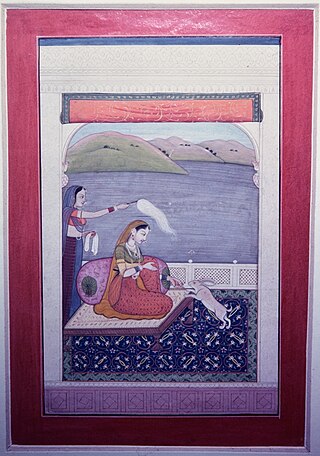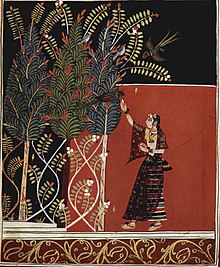
Sorath is an India musical raga that appears in the Sikh tradition from northern India and is part of the Sikh holy scripture called Sri Guru Granth Sahib. Every raga has a strict set of rules which govern the number of notes that can be used; which notes can be used; and their interplay that has to be adhered to for the composition of a tune. In the Guru Granth Sahib, the Sikh holy Granth (book) there are a total of 60 raga compositions and this raga is the twenty fifth raga to appear in the series. The composition in this raga appear on a total of 65 pages from page numbers 595 to 660.

Raga Ramkali is a raga in Hindustani classical music and can be themed around soothing things a man would say to please a discontent wife, it is an early morning raga belonging to Bhairav Thaat. In this raga, as in Bhairav, Rishabh and Dhaivat are Komal(flat), but the Teevra and the flat nishad are added. The vadi-samvadi are Pancham and Shadja. The aroha is S r G M P, G M d N S' and the avroha is S' N d P m P, d (N)d P, G M r S. Flat nishad and sharp madhyama are used often.

This is an India musical raga (composition) that appears in the Sikh tradition from northern India and is part of the Sikh holy scripture called Sri Guru Granth Sahib or Guru Granth Sahib for short. Every raga has a strict set of rules which govern the number of notes that can be used; which notes can be used; and their interplay that has to be adhered to for the composition of a tune. In the Guru Granth Sahib, the Sikh holy Granth (book) there are a total of 31 raga compositions and this raga is the ninth raga to appear in the series. The composition in this raga appear on a total of only 2 pages from page numbers 719 to 721.

Bihagara is an Indian musical raga (composition) that appears in the Sikh tradition from northern India and is part of the Guru Granth Sahib. Every raga has a strict set of rules which govern the number of notes and their interplay that has to be adhered to for the composition of a tune. The Guru Granth Sahib consists of 60 ragas and this is the twenty-second raga to appear in the series. The composition in this raga appears from page 537 to 557.

Bilaval or Bilawal is a raga and the basis for the eponymous thaat in Hindustani classical music. Raga Bilaval is named after Veraval, Gujarat.

Bhairav is a Hindustani classical raga of Bhairav thaat. It is a sampurna raga that is traditionally performed in the morning and also as the beginning piece in concerts. It is the defining raga of its own Thaat.

Devagandhari is a raga in Indian classical music. In carnatic classical music, Devagandhari is a janya raga, whose melakarta raga is Shankarabharanam, 29th in the 72 Melakarta raga system. This is not to be confused with Karnataka Devagandhari, which is a janya of Kharaharapriya similar to Abheri.

Dhanasree is a raga. It prominently appears in the Sikh tradition from northern India and is part of the Guru Granth Sahib.

This is an India musical raga (composition) that appears in the Sikh tradition from northern India and is part of the Guru Granth Sahib. Every raga has a strict set of rules which govern the number of notes that can be used; which notes can be used; and their interplay that has to be adhered to for the composition of a tune.

Bhairavi is a Hindustani Classical heptatonic (Sampurna) raga of Bhairavi thaat. In Western musical terms, raga Bhairavi employs the notes of the Phrygian mode, one of the traditional European church modes.
Brindaavani Sarang or Brindaabani Sarang, also known as raga Sarang, is a Hindustani classical raga. It is also called Vridaavani Sarang. This raga falls under the category of Sarang ragas.
Sohini is a raga in Hindustani classical music in the Marwa thaat. Alternate transliterations include Sohani and Sohni. Like Bahar, it is a small raga, with not much space for elaboration. It emotes the feel of longing, of passive sensuousness.

Marva or Marwa portrays being with one's lover and is often portrayed in Ragamala paintings as two couples kissing. It is a hexatonic Indian raga; Pa is omitted. Marva is the eponymous raga of the Marva thaat.

Hindol is a Hindustani classical raga from the Kalyan Thaat.
Jaijaivanti or Jaijaiwanti is a Hindustani classical raga belonging to Khamaj Thaat. According to the Guru Granth Sahib, this raga is a mixture of two others: Bilaval and Sorath. The raga appears in the latter section in Gurbani, as only four hymns were composed by Guru Tegh Bahadur, the ninth Sikh guru. These hymns were added by his son and successor Guru Gobind Singh in 1705 A.D. This raga is not mentioned in any Indian classical scriptures on music nor in the Ragmala.

Suhi, a very old North Indian raga.: it also appears in the Sikh tradition from northern India and forms part of the Guru Granth Sahib. In the Guru Granth Sahib, the composition appear in 62 ragas and this is the thirty first raga to appear in the series. The composition in this raga first appear on Ang number 728.
Nat Bhairav is a Hindustani classical heptatonic (Sampurna) raga of Bhairav Thaat. Traditionally it is a morning raga. It is one of the most important ragas of the Bhairav anga.

Rishabha is the second svara out of the seven svaras of Hindustani music and Carnatic music. Rishabha is the long form of the syllable रे for simplicity while singing the syllable. Rishabha is pronounced as Re and Ri.

Madhyam is the fourth svara from the seven svaras of Hindustani music and Carnatic music. This article is written from the Hindustani perspective. Madhyam is the long form of the syllable म. For simplicity in pronouncing while singing the syllable, Madhyam is pronounced as Ma. It is also called as मध्यम in the Devanagri script.















